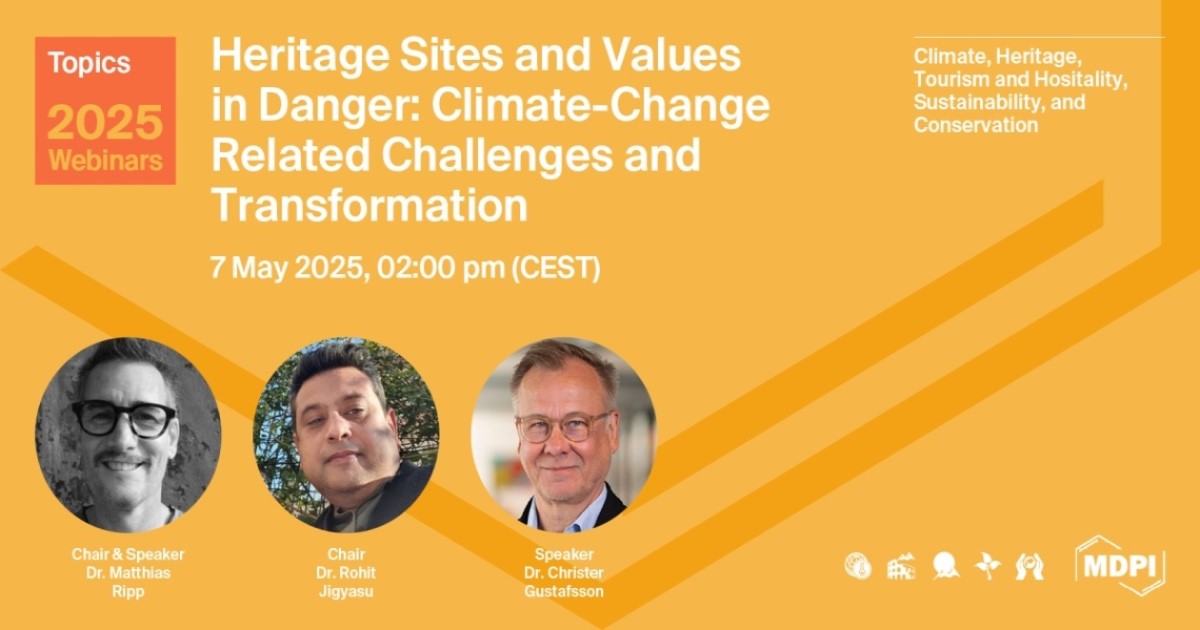Topic Editors


(World) Heritage Sites and Values in Danger: Climate-Change Related Challenges and Transformation
Topic Information
Dear Colleagues,
Climate change and other regional or global challenges, like armed conflict, demographic changes, economic crises, mass tourism and many others, pose serious threats and have had a great impact on many (world) heritage sites around the globe. A significant number of sites are affected in a negative way, as heritage values are in danger and different parts of complete heritage systems are impacted. The understanding of cultural heritage is a holistic heritage approach that goes beyond traditional sectors of heritage as being tangible and intangible, but rather embraces the different parts together with people from cultural heritage. This MDPI topic collection across different scientific journals seeks to achieve the following aims:
- To discuss challenges, threats and transformation at (world) heritage sites;
- To provide examples and case studies to understand the effects and impacts;
- To contextualize change and transformation from a theoretical perspective;
- To understand the impact on heritage systems with a new heritage approach;
- To provide insights into successful governance approaches and tools to stimulate resilience for heritage sites;
- To reflect on recovery and mitigation approaches that are based on cultural heritage;
- To understand how the impacts are affecting different parts and users of the heritage systems.
The Topic Webinar “(World) Heritage Sites and Values in Danger—Climate-Change Related Challenges and Transformation” was held online on 7th May 2025. Its primary focus was on the threats that climate change and disasters pose to global cultural heritage, aspects of the circular economy and cultural heritage, heritage-based urban development, and new heritage approaches that view heritage as a system and process and goes well beyond traditional narratives of preservation. This well-attended webinar featured interdisciplinary discussions and explored a diversity of questions on cultural heritage strategies, urban resilience, and governance models. The keynote speakers were Dr. Rohit Jigyasu, Prof. Dr. Christer Gustafsson, and Dr. Matthias Ripp, the last of whom also chaired the webinar. The full recording can be found at https://sciforum.net/event/topics-33?section=#recording.
Dr. Matthias Ripp
Prof. Dr. Christer Gustafsson
Dr. Rohit Jigyasu
Topic Editors
Keywords
- cultural heritage
- climate change
- transformation
- conservation
- urban planning
Participating Journals
| Journal Name | Impact Factor | CiteScore | Launched Year | First Decision (median) | APC | |
|---|---|---|---|---|---|---|

Climate
|
3.2 | 5.7 | 2013 | 21.6 Days | CHF 1800 | Submit |

Heritage
|
1.9 | 3.7 | 2018 | 18.6 Days | CHF 1600 | Submit |

Tourism and Hospitality
|
- | 3.7 | 2020 | 17.6 Days | CHF 1200 | Submit |

Sustainability
|
3.3 | 7.7 | 2009 | 19.3 Days | CHF 2400 | Submit |

Conservation
|
1.9 | 3.2 | 2021 | 26.4 Days | CHF 1200 | Submit |

Preprints.org is a multidisciplinary platform offering a preprint service designed to facilitate the early sharing of your research. It supports and empowers your research journey from the very beginning.
MDPI Topics is collaborating with Preprints.org and has established a direct connection between MDPI journals and the platform. Authors are encouraged to take advantage of this opportunity by posting their preprints at Preprints.org prior to publication:
- Share your research immediately: disseminate your ideas prior to publication and establish priority for your work.
- Safeguard your intellectual contribution: Protect your ideas with a time-stamped preprint that serves as proof of your research timeline.
- Boost visibility and impact: Increase the reach and influence of your research by making it accessible to a global audience.
- Gain early feedback: Receive valuable input and insights from peers before submitting to a journal.
- Ensure broad indexing: Web of Science (Preprint Citation Index), Google Scholar, Crossref, SHARE, PrePubMed, Scilit and Europe PMC.



